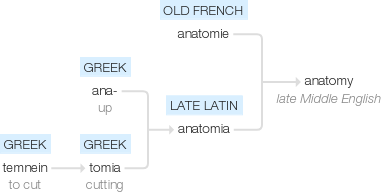Anatomy
late Middle English: from Old French anatomie or late Latin anatomia, from Greek, from ana- ‘up’ + tomia ‘cutting’ (from temnein ‘to cut’).
wiktionary
From French anatomie, from Latin anatomia, from Ancient Greek *ἀνατομία(*anatomía), from ἀνατομή(anatomḗ, “dissection”), from ἀνά(aná, “up”) + τέμνω(témnō, “I cut, incise”) (surface analysis ana- + -tomy), literally “cut up”. Doublet of ottomy.
etymonline
anatomy (n.)
late 14c., "study or knowledge of the structure and function of the human body" (learned by dissection); c. 1400, "anatomical structure," from Old French anatomie and directly from Late Latin anatomia, from late Greek anatomia for classical anatome "dissection," literally "a cutting up," from ana "up" (see ana-) + temnein "to cut" (from PIE root *tem- "to cut").
"Dissection" (1540s), "mummy" (1580s), and "skeleton" (1590s) were primary senses of this word in Shakespeare's day; meaning "the science of the structure of organized bodies" predominated from 17c. Of persons, "the body," from 1590s. Often misdivided as an atomy or a natomy (see N).
The scyence of the Nathomy is nedefull and necessarye to the Cyrurgyen [1541]
